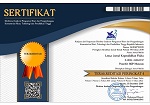Penerapan Metode Mindscaping dalam Pembelajaran Fisika sebagai Upaya Meningkatkan Hasil Belajar Siswa
DOI:
https://doi.org/10.33394/j-lkf.v6i2.1145Keywords:
mindscaping method, learning outcomesAbstract
[Title: The Implementation of Mindscaping Method in Physics Learning as an Effort to Improve Student Learning Outcomes]. This study aims to improve the activities and outcomes of student physics learning by applying the mindscaping method. This type of research is classroom action research conducted in three cycles. Each cycle consists of planning, action, observation, evaluation and reflection. Student learning activity data is obtained by observation while student learning outcomes data are obtained by giving objective tests at the end of each cycle. The application of the mindscaping method in this study is said to be successful if 85% of students achieve learning outcomes greater or equal to 65, while student learning activities are at least active categories. The results of the study showed an increase in student learning activities each cycle, namely in the first cycle the category was quite active to be very active in the second cycle and in the third cycle. Student learning outcomes can be seen from the classical completeness value which has increased in each cycle, each has a value of 76% in the first cycle, 80% in the second cycle, and 92% in the third cycle. Thus it can be concluded that the application of the mindscaping method has succeeded in increasing the activities and results of student physics learning.References
Ali, M. (2002). Guru Dalam Proses Belajar Mengajar. Bandung: Sinar Baru Algensindo.
Arikunto, S. (2003). Dasar-Dasar Evaluasi Pendidikan. Jakarta: Bumi Aksara.
Aqib, Z. (2002). Profesionalisme Guru Dalam Pembelajaran. Surabaya: Insan Cendikia.
Buzan, T. (2005). Buku Pintar Mind Map Untuk Anak. Jakarata: Gramedia Pustaka Utama.
Dewi, K, P. (2017). Pengembangan Bahan Ajar Berbasis Mindscape pada Materi Benua bagi Mahasiswa PGSD UAD. The 6th University Research Colloquium 2017 Universitas Muhammadiyah Magelang.
Dirjen Pendidikan Dasar dan Menengah. (2004). Materi Latihan Terintegrasi (Pendekatan Pembelajaran Matematika). Jakarta: Depdiknas.
Djamarah, S. B dan Aswan, Z. (2006). Strategi Belajar Mengajar. Jakarta: PT. Rineka Cipta.
Djamarah. S. B. (1994). Prestasi Belajar dan Kompetensi Guru. Surabaya: Usaha Nasional.
Eis, E, S. (2012). Remediasi Miskonsepsi Siswa Menggunakan Mindscaping tentang Kalor Di SMP. Program Studi Pendidikan Fisika FKIP Untan.
Hamalik, O. (2001). Proses Belajar Mengajar. Jakarta: PT Bumi Aksara.
------- 2002. Kurikulum dan Pembelajaran. Jakarta: PT Bumi Aksara.
http://fisikasmp.wordpress.com/2009/04/11/pengertian-fisika/(diakses 21 April 2009).
http://www.fisikanet.lipi.go.id(di akses 21 April 2009).
Kunandar. (2008). Langkah Mudah Penelitian Tindakan Kelas Sebagai Pengembangan Profesi Guru. Jakarta: Raja Grafindo Persada.
Margulies, N., Christine, V. (2008). Pemikiran Visual. Jakarta: PT Indeks.
Mulyasa. (2004). Implementasi Kurikulum 2004 Panduan Pembelajaran KBK. Bandung: PT Remaja Rosdakarya.
Nurkancana, W., Sunartana. (1990). Evaluasi Hasil Belajar. Jakarta: Usaha Nasional.
Sonneman, M, R. (2002). Mahir Berbahasa Visual: Menungkapkan Gagasan Lebih Cepat Daripada Kata. Bandung: Kaifa.
Sudjana, N., Ahmad R. (2001). Media Pengajaran. Jakarta: Sinar Baru Algensindo.
Syah, M. (2005). Psikologi Belajar. Jakarta: Rajawali Press.
Downloads
Published
How to Cite
Issue
Section
License
Authors who publish with Lensa: Jurnal Kependidikan Fisika agree to the following terms:
- For all articles published in Lensa: Jurnal Kependidikan Fisika, copyright is retained by the authors. Authors give permission to the publisher to announce the work with conditions. When the manuscript is accepted for publication, the authors agree to automatic transfer of the publishing right to the publisher.
- Authors retain copyright and grant the journal right of first publication with the work simultaneously licensed under a Creative Commons Attribution-ShareAlike 4.0 International License that allows others to share the work with an acknowledgment of the work's authorship and initial publication in this journal.
- Authors are able to enter into separate, additional contractual arrangements for the non-exclusive distribution of the journal's published version of the work (e.g., post it to an institutional repository or publish it in a book), with an acknowledgment of its initial publication in this journal.
- Authors are permitted and encouraged to post their work online (e.g., in institutional repositories or on their website) prior to and during the submission process, as it can lead to productive exchanges, as well as earlier and greater citation of published work (See The Effect of Open Access).

This work is licensed under a Creative Commons Attribution-ShareAlike 4.0 International License.



